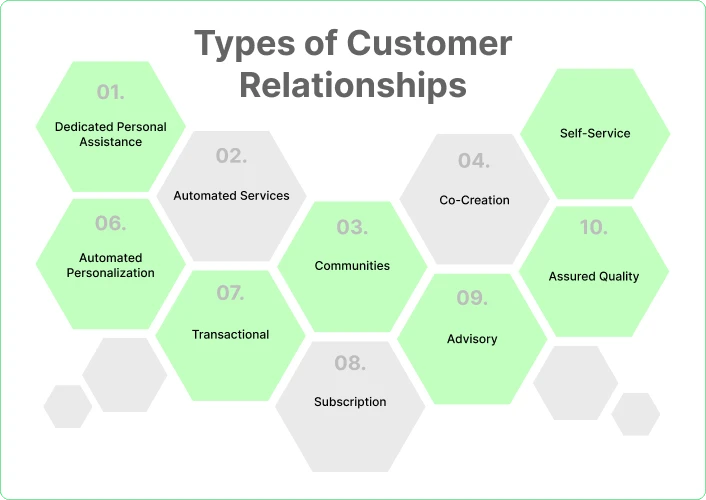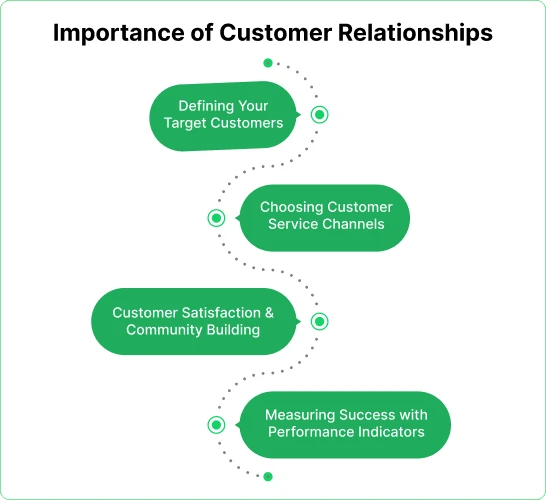 Business Solutions
, Customer Experience
Business Solutions
, Customer Experience

05 May, 2024

A must-have tool to map your business strategies, the business model canvas (BMC) features 9 separate sections. Customer Relationships (CR) is one of the most important areas of the BMC that’s essential to satisfy your customers and turn them into loyal patrons. As a business owner, you must understand what is Customer Relationships in Business Model Canvas.
It’s a crucial building block of the BMC that depicts whether an organization provides one-on-one or automated customer service. The goal of CR is to drive and retain new clients to increase sales.
Read on as I walk you through the different aspects of Customer Relationships in BMC and explain why it’s essential to grow your brand.
Contents
Simply put, customer relationships describe how your business representatives interact with their customers. In BMC, ‘customer relationships’ is a highly strategic and effective tool that helps business owners to understand and manage their interactions and relationships with the customers.
Successful management of customer relationships allows you to employ the right strategies, channels, and structures to establish and maintain connections with your target customers.
For example, a fitness brand can offer personalized coaching plans, workout guides, and healthy recipes to engage audiences. After that, running social media groups, organizing fitness challenges, asking for feedback, etc., will strengthen the brand’s customer relationships.
To get a visual representation of the concept, check out this free Customer Relationship Business Model Canvas pdf.
Practical BMC examples are the best way to understand the concept and its key elements. Here are some of the most popular businesses and services with their customer relationship methods and strategies:
Amazon, eBay, Walmart, etc., are the most popular e-commerce sites available today. Although common, these sites are not the ideal examples of customer relationships in my opinion.
The reason is the lack of personalized service. Most e-commerce sites include extensive FAQs, detailed product descriptions, user reviews, and intuitive search functionalities to facilitate customer relationship building.
Some sites offer real-time assistance through chatbots, or human agents address customer queries promptly.
All media-based platforms like Netflix and Spotify use subscription-based CR methods. This way, they develop a recurring relationship with exclusive content and features.
To increase engagement, content and media platforms have sharing options and social media buttons that allow users to connect with friends.
From Facebook to X, all social media platforms offer personalized feeds for an interactive and engaging user experience. If you ask me, this is one of the best CR models out there. That’s because the algorithms curate content based on user preferences.
They connect and interact with each other directly, building a strong community and inviting more users.
So, what is the objective of dedicating a separate section to Customer Relationships? Here’s the crucial role of the CR block in BMC:
When you elaborate on the concept of customer relationship, customer acquisition comes at the top. In BMC, the CR block allows you to develop techniques to attract new customers and convert them into paying users.
You can employ ideas and your product-related information on various social media platforms, blogs, and forums. Other popular ways of customer acquisition include email marketing, customer research, generating leads, etc.
Now that you’ve grabbed the attention of a potential customer, the next step is to make them stay. The CR block allows you to develop a clear vision to encourage existing customers to continue using your products or services.
Dedicating a separate section to display customer feedback, creating useful content to keep them engaged, and adding exciting products are some effective practices.
The BMC is divided into two sections including execution and value creation. By increasing sales and customer lifetime, the customer relationship block achieved its place in the value creation section.
When you utilize it correctly, it helps you build a loyal customer base. One popular strategy for upselling and cross-selling is offering additional products or services that complement their initial purchase.
When a company or brand regularly interacts with its recurring customers, it fosters loyalty, and trust, and enhances brand advocacy.
This way, by creating an effective CR block, you can spread word-of-mouth regarding your services or products and build a strong brand community.
While establishing CR models, you have numerous options to choose from. Depending on the objective of your business or service, you can establish any of the following Customer Relationship types:

For one-on-one interactions with the customers, you can choose the dedicated personal assistance CR model and assign a specific representative to handle individual customer needs.
It offers personalized support and helps you to build strong relationships. However, establishing such relationships is time-consuming and costly.
Example: Wealth management firms
Instead of a representative, you can automate your customer services by utilizing technology like chatbots, FAQs, or self-service portals.
Customers can access information, complete tasks, or get basic support without direct human interaction. Although quicker, it can’t provide personalized services.
Example: Online e-commerce payment platforms
This includes creating online forums, user groups, or events to establish a community for peer-to-peer support. Such relationships increase engagement and brand loyalty.
Example: Online gaming communities
Here, business owners can involve their customers in product development or improvement through surveys, feedback forums, or workshops. It’s a great way to provide a sense of ownership and increase customer satisfaction.
Example: Lego’s Ideas platform
As the name suggests, this type of relationship allows customers to find information, solve problems, or complete tasks independently. The service provider offers tools and resources to reduce their reliance on direct support.
Example: IKEA assembly instructions
To let the clients choose their preferred content, here the business owner sets up data and algorithms to personalize services. Clients get recommendations or offers based on their preferences and behavior.
Example: Spotify’s Discover Weekly playlists
When you don’t need recurring buyers or a loyal customer base, choose transactional customer relationships. These one-time interactions are focused on completing a specific purchase or service without building an ongoing relationship.
Example: Vending machine purchase
Contrary to transactional relationships, subscription-based businesses offer recurring access to products or services for a regular fee. It establishes a continuous customer relationship and predictable revenue stream.
Example: Netflix subscriptions
To build trust with customers, people who utilize the advisory CR model provide expert guidance and recommendations. The suggestions fulfill individual customer needs and encourage them to build long-term relationships.
Example: Financial advisors
An excellent way to make the customers purchase with confidence is to guarantee a certain level of quality or performance.
Most companies do it through warranties, guarantees, or service-level agreements. It not only enhances brand value but also increases the chances of repeat business.
Example: AppleCare product warranties
Your customer relationship strategies can make or break your brand. Therefore, customer relationships are the lifeblood of any successful business. Here’s why they hold such importance:

This leads to satisfied customers who are more likely to return and recommend your brand to others. On the contrary, statistics have shown that 59% of buyers will stop dealing with a company after several unpleasant experiences.
Good customer relationships aid in creating a loyal customer base. Loyal customers are more likely to continue purchasing from the business, even in the face of competition or price changes. It reduces your customer acquisition costs and ensures a consistent revenue stream.
When customers feel valued and appreciated, they promote your products or services through positive reviews. Such organic marketing carries significant weight and attracts new customers without additional advertising.
Close relationships with customers provide valuable feedback to improve your products and customer engagement strategies. It allows you to stay innovative and competitive in the market.
During economic downturns or other challenges, businesses with strong customer relationships are better positioned to weather the storm. Your loyal customers will be more forgiving of temporary setbacks and keep supporting the business through tough times.
Acknowledging the various implications of the Customer Relationship block in the BMC is essential to developing a foolproof strategy with the right metrics. Here are some key implications:
Before anything else, you must decide the targeted audience you want to promote your business to.
Select the type of relationship you want to build with each customer segment. It can be transactional interactions, personalized services, or long-term partnerships.
Social media, email, phone calls, dedicated chat boxes, etc., are some popular customer service channels. Choose the right channel depending on your business type and customers’ preferences.
You can also integrate various channels to create a seamless customer experience across all touchpoints.
Fix your aim to provide exceptional customer service and address concerns promptly and efficiently. If possible, build a separate community for your regular customers to connect, share experiences, and provide feedback.
Establish key performance indicators (KPIs) and related metrics to track the effectiveness of your customer relationship strategies.
You can keep records of customer satisfaction scores, churn rate, and repeat purchase rate. Analyze these records to identify areas for improvement and refine your customer relationship management.
Understanding Customer Relationships in Business Model Canvas is one of the essential basics for any business owner. In BMC, the Customer Relationships building block focuses on how a business interacts with its customers to create, maintain, and strengthen those relationships. It’s all about understanding how you’ll connect and deliver value to your target audience.
It helps you drive customer loyalty, repeat business, word-of-mouth marketing, and feedback for improvement. In today’s time, customers are more vocal than ever before about brands and their services. Therefore, you must have a clear idea of every corner of the CR block to enhance brand advocacy and reduce your marketing costs.
Got more queries? Let’s take a look at some common questions business owners often have regarding BMC customer relationships.
The Value Proposition Canvas Customer Relationship focuses on understanding how a business interacts with its target audience. It examines the “customer jobs” – the tasks your ideal customer is trying to accomplish – and maps them to the relationship aspects your business offers.
In today’s world, Customer Relationship Management (CRM) helps businesses manage all interactions with their customers. CRM systems track customer behavior and purchase history, allowing businesses to personalize communication, offer targeted promotions, and resolve issues efficiently.
Customer Relationship Marketing is essential for building long-term relationships with your existing customer base. It’s more cost-effective and allows you to understand your customer’s needs and preferences better.